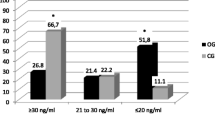Abstract
The use of intestinal segments in genitourinary reconstruction could influence vitamin metabolism and affect the skeletal bone and its mineral content in the long term. In 137 patients, serum levels of the vitamins A, B1, B2, B6, B12, D, and E and of folic acid, bile acid, and ammonia as well as levels of intracorpuscular vitamin B12 and folic acid were examined and a red blood cell count was performed. The patients were divided into three groups (≤2 years, >2 to ≤4 years, and >4 years after surgery) as well as into children and adults. In addition, bone mineral density (dual-photon absorptiometry) was measured in 25 patients. Of these, 16 patients were ≈16.8 years s/p rectal reservoir, 6 were ≈20.5 years s/p colonic conduit, two were 6 and 8 years s/p ileocecal pouch, and one adolescent was 5 years s/p ileal bladder augmentation. In all patients the levels of vitamins A, B1, B2, B6, D, and E and of folic acid, bile acid, and ammonia as well as the red blood cell count were within normal ranges. In children (n= 51) there was no significant drop in vitamin B12 levels after the operation. In adults (n= 86), serum vitamin B12 levels dropped significantly from 402 ± 182 ng/l during the first 2 years after the operation to 292 ± 204 ng/l after the 4th year (normal range 240–1,100 ng/l). No significant increase in the intracorpuscular vitamin B12 level was observed during the same period. The bone mineral density was normal in all 25 patients with different types of urinary diversion. In addition to regular examination (sonography, creatinine levels, and base excess), vitamin B12 levels should be determined at 4 years after urinary diversion. It remains unclear whether substitution is necessary. However, substitution is easy to achieve and cheaper than the regular determination of vitamin B12. No decrease in bone mineral content was seen in the long-term follow-up with early correction of the base excess (below −2.5).
Similar content being viewed by others
Author information
Authors and Affiliations
Rights and permissions
About this article
Cite this article
Stein, R., Lotz, J., Andreas, J. et al. Long-term metabolic effects in patients with urinary diversion. World J Urol 16, 292–297 (1998). https://doi.org/10.1007/s003450050069
Issue Date:
DOI: https://doi.org/10.1007/s003450050069



